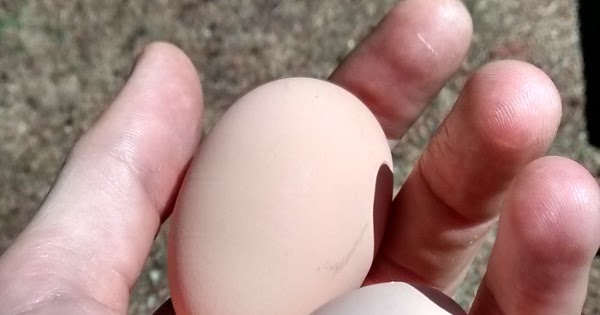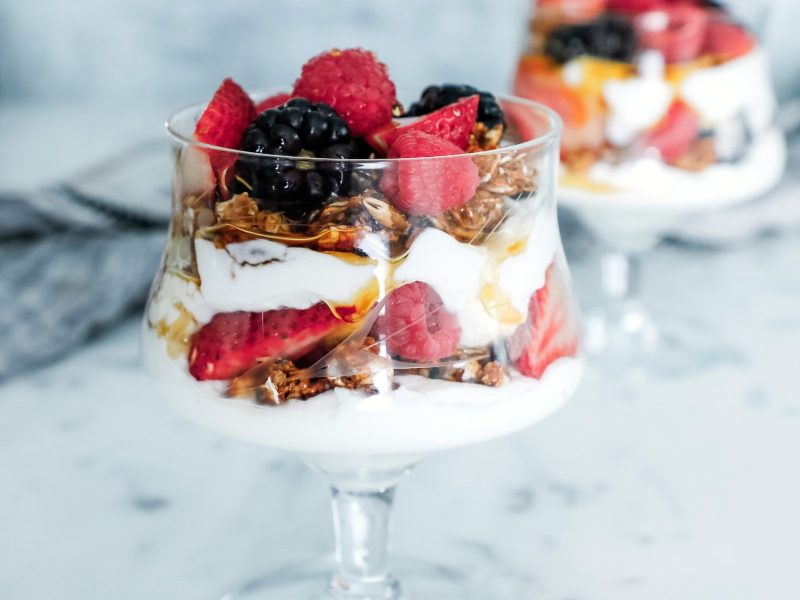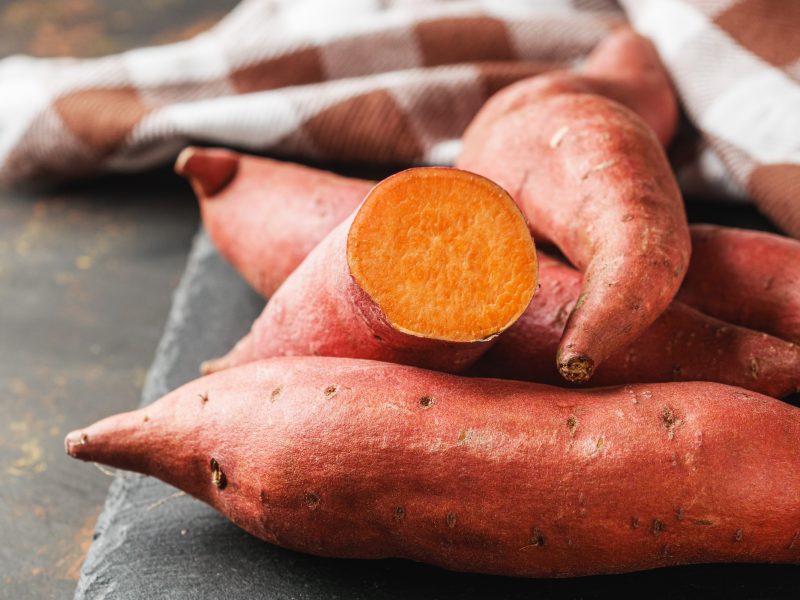In my food choices, I try to strike a balance between nutrition, cost, time efficiency, animal welfare, pleasure, and environmental impact. I’m the chef of my household of two, and I cook two meals a day, almost every day, typically from single ingredients. I prefer organic, but I don’t insist on it.
| Eggs from my hens |
My diet changes seasonally because I grow much of my own food. This started out with vegetables, but recently has expanded to staple foods such as potatoes, flour corn, and winter squash. I also have a small flock of laying hens that turn table scraps, bugs, grass, and chicken feed into delicious eggs.
The primary guiding principle of my diet is to eat somewhere between a “Paleolithic”-style diet and a traditional agricultural/horticultural diet. I think of it as a broad ancestral diet. Because it’s partially inspired by agricultural/horticultural diets, starch is the main calorie source.
My meals are organized around three food groups: a protein, a starch, and vegetables/fruit. If any of those three are missing, the meal doesn’t feel complete. I’ll start with those categories and move on from there.
I eat some form of fresh meat about every other day, most often poultry or fish. Lately I’ve been eating deer from my chest freezer (my hunting season was unsuccessful, but I got meat anyway because my hunting partner was successful and I helped him butcher). My meat portions are usually modest, and I often put it into stews and other such dishes to extend it. I also tend to buy whole animals or cuts with bones, so I can make bone broth, which I use to pep up soups and stews. For example, I often roast whole chickens or fish. I rarely eat processed meat.
When I’m not eating meat, I’m usually eating beans, lentils, or eggs. I eat a lot of beans and lentils because they’re healthy, environmentally friendly, inexpensive, and don’t raise animal husbandry concerns. There is abundant evidence that humans have been eating legumes since long before agriculture, and historical hunter-gatherers also relied on a wide variety of legumes. I buy dry beans in bulk and soak them overnight before cooking. It’s so cheap, it might as well be free. I eat 1-2 eggs per day.
In addition to eggs, I also make my own yogurt from whole milk. I go through about a pint of it a week. Eggs and yogurt keep me satisfied on days when my meals would otherwise not contain any animal food. I love cheese, but I don’t eat it very much because I don’t usually have bread around.
I eat a lot of unsalted roasted nuts and peanuts, and a fair amount of peanut butter. I keep a giant bag of unsalted, roasted in-shell peanuts around in case I want a snack. Because I have to shell them individually and they aren’t salted, I don’t overeat them. I also usually have a jar of raw almonds on hand, which I use for snacking, for almond milk, and as an ingredient in stews. Unsalted nuts and fresh fruit are typically the only visible, immediately edible foods in my kitchen.
Starch
Potatoes reign as my single largest source of calories from September through March. We harvested 800 lbs of potatoes from the garden last season, and we’ve already gone through most of them. Contrary to claims that the quickly-digesting starch in potatoes makes you hungry and fat, I find that potatoes keep me full for a long time, and I certainly haven’t gained any weight. I usually bake or microwave them whole, and eat them plain as part of my meals. I also sometimes toss them in a little oil and turn them into oven fries for a treat. The skins go to our hens.
 |
| Our potato field. You can see some corn on the top right. |
I eat a variety of grains and pseudograins, particularly corn, rolled oats, brown and white rice, and buckwheat. I eat oats with mineral-rich yogurt to make up for its high level of phytic acid. I also make popcorn sometimes. I don’t eat much wheat, but I do eat whole grain bread from time to time, and white bread or pasta on special occasions.
I often use buckwheat, rice, and chickpeas to make a sort of starchy “pancake”. I soak the ingredients overnight, rinse well, grind it all into a fine batter in my Vita-Mix with salt, and then use the batter to make thick, savory pancakes onto which I put other foods. I invented this recipe, but it’s inspired by the practices of many traditional cultures.
I grow flour corn (Painted Mountain), and use most of it to make masa. This involves the traditional South American method of nixtamalization, which makes corn more digestible and nutritious. Nixtamalizing and grinding the corn is labor-intensive, but it results in satisfying, hearty tortillas and tamales. I also use the corn to make make hominy and flour.
| Painted Mountain flour corn |
 |
| Homemade tortillas from PM corn. Note the purple color, which results from the corn’s high polyphenol and carotenoid content. |
I grow a large amount of sweet and starchy winter squash. We eat it fresh over the course of about 6 months, and put a lot of cooked squash into the chest freezer for the rest of the year. I grow gourmet varieties, such as ‘delicata’ and ‘Oregon homestead sweet meat’, which don’t require added sugar or fat to taste good. I either roast them and serve them plain, or use them in soups and stews. I feed the skins and small seeds to my hens, and the big seeds to myself.
Vegetables and fruit
 |
| Me ‘n my giant broccoli. |
Most of the vegetables I eat come from my garden. Since I live in the Maritime Northwest, conditions are favorable for cool-weather crops 8+ months of the year. Some hardy plants, like kale, can survive year-round, and even be somewhat productive in winter. I tend to eat a lot of lettuce and kale because they’re usually abundant. Broccoli also thrives here for most of the year.
 |
| Garden tomatoes |
In summer, we eat a lot of green beans, tomatoes, and summer squash.
I supplement my garden produce with store-bought onions, carrots, celery, canned tomatoes, avocados, and occasionally other vegetables. I eat a lot of onions. I buy 10-lb bags of yellow onions, put them in the garage, and we don’t have any trouble going through them before they spoil.
I make my own sauerkraut, which we eat raw because we like the crunch. Overall, I probably eat about 3-5 servings of vegetables per day.
I love fruit and I eat a lot of it. I’ll eat any fruit, but I eat apples, bananas, and blueberries the most. I harvest a variety of berries from my garden in summertime, and put some in my chest freezer for fall and winter. I probably average about 3-5 servings of fruit per day (keep in mind that a medium apple is about two servings). Fruit is the only dessert I eat, with rare exceptions.
Fats, salt, sugar, and other flavorings
I use the minimum amount of added fat I need to make my food palatable. I don’t measure how much I use, but it’s not a lot. Most of my added fat is extra-virgin olive oil, but I also use modest amounts of grass-fed butter and high-oleic sunflower oil. I use olive oil, cider vinegar, and mustard to make big batches of vinaigrette dressing that I keep on my counter for use on salad and other vegetables.
I use salt in my cooking, but again only the minimum required to make my food palatable.
I almost never use sugar in my food, except occasionally when I’m entertaining and I decide to make a fancy dessert (e.g., flan). I use a little bit of honey here and there, but not often. I don’t use other added sweeteners.
A variety of herbs and spices make their way into my food, but the most common are bay leaf, chili pepper, rosemary, garlic, and thyme (I grow the last three in my garden). I use soy sauce and sriracha sometimes.
I tend to cook simply, focusing on the satisfying flavors of quality ingredients rather than relying heavily on added fats, sugar, salt, and flavors.
Beverages
My primary beverage is water, either straight from the tap, or carbonated from my keg (usually with a little added flavor, like grapefruit rind and citric acid).
I average about 5 alcoholic drinks a week, typically hard cider or wine, but sometimes also beer or spirits. I make my own cider, wine, and beer. I much prefer my own dry cider to the alcoholic apple juice that’s sold in the US. I generally avoid drinking alcohol two nights in a row.
I drink black tea on most mornings, with nothing in it. Sometimes I’ll have half-caf coffee, with or without a splash of milk.
I can’t remember the last time I drank sweet soda, and I don’t even enjoy it at this point in my life. I do occasionally drink Gatorade on particularly strenuous cycling or backpacking trips.
Junk food
I eat junk food sometimes. By that I mean highly palatable, calorie-dense, nutritionally questionable foods. Pizza and ice cream are two of my favorites, but I also sometimes eat tortilla chips, bacon, French fries, or other goodies. When I eat junk food in public, I make jokes about looking out for paparazzi.
Honestly, if I were to add it all up, including when I go to restaurants and have dinner with friends, I probably eat some kind of junk food at least once a week. I don’t feel guilty; I just enjoy it. It’s all part of the plan.
I eat at a restaurant about twice a month, which isn’t necessarily junk food, but is rarely as healthy as what I cook. Most of us tend to overeat at restaurants, and I’m no exception.
I buy 25-pound bags of white sugar at Costco. I use it to make (dry) fruit wine, but it sure does look bad! If you see me on the cover of a tabloid magazine, clutching a giant bag of sugar with a crazed look in my eye, you’ll know what happened.
Supplements
The only supplement I take is vitamin D3 in winter. My goal is to take 1000 IU per day, but I usually forget.
A day in my life
Now you know what ingredients I use, but not how I use them. Here are a few examples of typical meals.
Breakfast
I alternate between two breakfasts: a plain (baked or microwaved) potato and a fried egg, or oatmeal, yogurt, and blueberries.
Lunch
Lunch is usually catch-as-catch-can. Typically, I’ll eat dinner leftovers with a potato or tortillas, and a piece of fruit. Sometimes I’ll crack open a can of salmon or sardines (canned in water). Nuts are usually involved.
Dinner
My most frequent dinner is some kind of thick stew made with meat or beans/lentils, plus onions, other vegetables, and a couple of herbs or spices. The base is usually bone broth or diced tomatoes. I also roast whole chickens, turkeys, and fish, and I poach salmon steaks.
I also often make a bed of cooked vegetables in a sauce made of stewed tomatoes, olive oil, and herbs, crack two eggs into it per person, and cook with the lid on.
I eat the main dish with a generous helping of potatoes, rice, tortillas, or my savory grain “pancakes”. There’s also typically a side of vegetables: most often some kind of salad with homemade vinaigrette, steamed broccoli with vinaigrette, roasted squash, or sauerkraut. Dessert is a piece of fruit, or, from time to time, dark chocolate.


